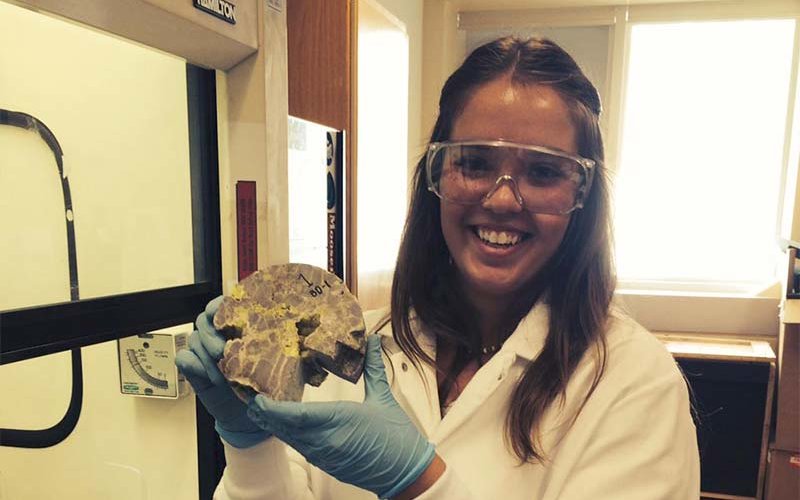
Geology alumna and national park ranger Kylie Caesar and her faculty research adviser, Sean J. Loyd, led a collaborative study that focused on mineral formation by a community of unique microorganisms — tiny living organisms invisible to the naked eye — in the U.S. Gulf Coast subsurface.
“Our findings suggest that microscopic organisms, also known as microbes, destroyed vast quantities of methane in the subsurface of the Gulf of Mexico region. Ultimately, these microbes limit the natural release of massive quantities of this potent greenhouse gases into the atmosphere,” said Loyd, assistant professor of geological sciences.
Their research was published in the peer-reviewed, open-access scientific journal Nature Communications, with Caesar the lead author of the paper. Loyd, J. Richard Kyle of the University of Texas at Austin, Timothy W. Lyons of UC Riverside and Aradhna Tripati of UCLA are all co-authors. Caesar worked on the research for nearly two years, under the mentorship of Loyd, for her master’s thesis. She graduated in 2016 with a master’s degree in geology.
“This research is important because it sheds light on how Earth can naturally regulate its greenhouse emissions,” said Caesar, a park ranger who works at Joshua Tree National Park in the winter and at Yosemite National Park during the summer.
“Certain rocks below the surface host complex ecosystems where microbes eat escaping greenhouse gases, such as methane, to acquire energy. The microbes consume the methane and prevent it from ever reaching the atmosphere, therefore decreasing the greenhouse effect and warming of our planet.”
Both methane and carbon dioxide in the atmosphere absorb energy from sunlight and “hold it” as heat, resulting in a global increase in temperature, Caesar added.
The researchers analyzed underground rock samples that form above salt domes — mounds of salt that are underneath Texas, Louisiana and the Gulf of Mexico — and used these data to characterize how the rocks formed.
“We discovered chemical signatures preserved in the rocks that indicate the presence of methane-eating organisms and determined that these rocks form as a byproduct of microbes in these salt dome environments, resulting from the consumption of methane,” Caesar relayed.
The research paper also provides insight into the formation and destruction of mineral resources. The methane consumption by microorganisms in the subsurface of the U.S. Gulf Coast produces extensive mineral deposits, including limestone, elemental sulfur and metal sulfides, which are so extensive that they are mined commercially, Loyd noted.
As a graduate student, Caesar presented her work at conferences and learned valuable and applicable skills, such as time management, communication, problem-solving and critical thinking skills, that she uses on the job today.
“Dr. Loyd was extremely supportive and helpful throughout the research process,” she said. “He gave me great flexibility in pursuing this research and allowed me to work on the project independently, while offering support. He also stressed the importance of scientific communication and collaboration, and imparted excellent presentation skills that I still continue to use after graduation.”